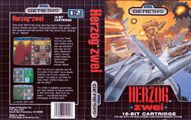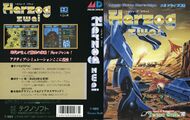Difference between revisions of "Herzog Zwei"
From Sega Retro
(→Legacy) |
|||
| Line 23: | Line 23: | ||
}} | }} | ||
}} | }} | ||
| − | '''''Herzog Zwei''''' (ヘルツォーク・ツヴァイ) is a video game developed by [[Technosoft]], released exclusively for the [[Sega Mega Drive]] in 1989, and a sequel to ''Herzog'', which was released | + | '''''Herzog Zwei''''' (ヘルツォーク・ツヴァイ) is a video game developed by [[Technosoft]], released exclusively for the [[Sega Mega Drive]] in 1989, and a sequel to ''Herzog'', which was only released for Japanese home computers in 1988. It was published in Japan by Technosoft in 1989 and in North America and Europe by [[Sega]] in 1990. |
| − | ''Herzog Zwei'' is often credited for creating the foundations of the real time strategy genre | + | ''Herzog Zwei'' is often credited for creating the foundations of the real time strategy genre as we know it today. |
| − | == | + | ==Gameplay== |
| − | + | In ''Herzog Zwei'', the player controls a unit which can freely transform from a plane to a robot, and must create and transport units to capture structures and destroy enemy bases. It combines concepts from the ''Thunder Force'' series (as it stood in 1989) with a strategic element which plays out in real time, as opposed to the more traditional turn-based strategy games which derive from games such as chess. | |
| − | ''Herzog Zwei'' | ||
| − | + | Along with a single-player mode, it features a split-screen two-player mode where both players are in action simultaneously. There are no pauses while decisions are taken, forcing players to think quickly while on the move. Though the player only controls one unit, a transforming mech, the manner of control foreshadowed the point-and-click mechanic of later games. It introduced much of the genre conventions, including unit construction and resource management, with the control and destruction of bases being an important aspect of the game, as were the economic/production aspects of those bases. | |
| − | |||
| − | |||
| − | |||
| − | |||
| − | |||
| − | |||
==Production Credits== | ==Production Credits== | ||
| Line 54: | Line 47: | ||
}} | }} | ||
| − | == | + | ==History== |
| − | + | ===Development=== | |
| − | + | The Western packaging art was created by veteran San Francisco game box illustrator [[Marc Ericksen]], who had previously created the art for ''[[Thunder Force II]]''. | |
| − | |||
| − | ==Legacy== | + | ===Legacy=== |
| − | + | ''Herzog Zwei'' went on to influence future RTS games, particularly 1992's ''[[Dune II]]''{{ref|https://web.archive.org/web/20030504034920/http://www.above-the-garage.com/rblts/vie16b.htm}}. | |
| − | + | With Technosoft closing its doors in 2001 and the status of the intellectual property being unknown, the future of the series is likely sealed. | |
==Physical Scans== | ==Physical Scans== | ||
Revision as of 15:51, 30 January 2016
| This article needs cleanup. This article needs to be edited to conform to a higher standard of article quality. After the article has been cleaned up, you may remove this message. For help, see the How to Edit a Page article. |
| Herzog Zwei | |||||
|---|---|---|---|---|---|
| System(s): Sega Mega Drive | |||||
| Publisher: Technosoft | |||||
| Developer: Technosoft | |||||
| Genre: Simulation | |||||
| Number of players: 1-2 | |||||
|
Herzog Zwei (ヘルツォーク・ツヴァイ) is a video game developed by Technosoft, released exclusively for the Sega Mega Drive in 1989, and a sequel to Herzog, which was only released for Japanese home computers in 1988. It was published in Japan by Technosoft in 1989 and in North America and Europe by Sega in 1990.
Herzog Zwei is often credited for creating the foundations of the real time strategy genre as we know it today.
Contents
Gameplay
In Herzog Zwei, the player controls a unit which can freely transform from a plane to a robot, and must create and transport units to capture structures and destroy enemy bases. It combines concepts from the Thunder Force series (as it stood in 1989) with a strategic element which plays out in real time, as opposed to the more traditional turn-based strategy games which derive from games such as chess.
Along with a single-player mode, it features a split-screen two-player mode where both players are in action simultaneously. There are no pauses while decisions are taken, forcing players to think quickly while on the move. Though the player only controls one unit, a transforming mech, the manner of control foreshadowed the point-and-click mechanic of later games. It introduced much of the genre conventions, including unit construction and resource management, with the control and destruction of bases being an important aspect of the game, as were the economic/production aspects of those bases.
Production Credits
- Main Program: Takashi Iwanaga
- Weapon Program: Haruhiko Ohtsuka
- Map Design: Osamu Tsujikawa
- Character Design: Izumi Fukuda
- Demo Program: Izumi Fukuda
- Music Compose: Naosuke Arai, Tomomi Ohtani
- Sound Effect: Naosuke Arai, Tomomi Ohtani
- Manual Writer:Fumio Sugano
- Herzog: T. O.
- Special Thanks: Marie Hughes, Kamometei
- Copyright: Tecno Soft
History
Development
The Western packaging art was created by veteran San Francisco game box illustrator Marc Ericksen, who had previously created the art for Thunder Force II.
Legacy
Herzog Zwei went on to influence future RTS games, particularly 1992's Dune II[1].
With Technosoft closing its doors in 2001 and the status of the intellectual property being unknown, the future of the series is likely sealed.
Physical Scans
| 70 | |
|---|---|
| Based on 30 reviews | |
| Mega Drive, CA |
|---|
|
References
- ↑ http://www.above-the-garage.com/rblts/vie16b.htm (Wayback Machine: 2003-05-04 03:49)
- ↑ 2.0 2.1 File:CGtC UK 04.pdf, page 31 Cite error: Invalid
<ref>tag; name ":File:CGtC UK 04.pdf_p31" defined multiple times with different content - ↑ 3.0 3.1 File:CVG UK 101.pdf, page 103 Cite error: Invalid
<ref>tag; name ":File:CVG UK 101.pdf_p103" defined multiple times with different content - ↑ File:EGM US 015.pdf, page 85
- ↑ File:EGM US BuyersGuide 1993.pdf, page 46
- ↑ 6.0 6.1 File:TGM UK 28.pdf, page 50 Cite error: Invalid
<ref>tag; name ":File:TGM UK 28.pdf_p50" defined multiple times with different content - ↑ 7.0 7.1 File:Joystick FR 010.pdf, page 102 Cite error: Invalid
<ref>tag; name ":File:Joystick FR 010.pdf_p102" defined multiple times with different content - ↑ 8.0 8.1 File:MegaTech UK 01.pdf, page 78 Cite error: Invalid
<ref>tag; name ":File:MegaTech UK 01.pdf_p78" defined multiple times with different content - ↑ 9.0 9.1 File:PlayTime DE 1991-06.pdf, page 116 Cite error: Invalid
<ref>tag; name ":File:PlayTime DE 1991-06.pdf_p116" defined multiple times with different content - ↑ File:PowerPlay DE 025.pdf, page 121
- ↑ 11.0 11.1 File:Raze UK 05.pdf, page 58 Cite error: Invalid
<ref>tag; name ":File:Raze UK 05.pdf_p58" defined multiple times with different content - ↑ 12.0 12.1 File:SegaPro UK 03.pdf, page 61 Cite error: Invalid
<ref>tag; name ":File:SegaPro UK 03.pdf_p61" defined multiple times with different content - ↑ 1700 igr dlya Sega, "" (RU; 2001-xx-xx), page 95
- ↑ Aktueller Software Markt, "Avril 1990" (DE; 1990-03-30), page 78
- ↑ Beep! MegaDrive, "February 1990" (JP; 1990-01-08), page 69
- ↑ Console XS, "June/July 1992" (UK; 1992-04-23), page 130
- ↑ Cool Gamer, "9" (RU; 2002-10-13), page 102
- ↑ Electronic Gaming Monthly, "May 1990" (US; 1990-xx-xx), page 20
- ↑ Entsiklopediya luchshikh igr Sega. Vypusk 1, "" (RU; 1999-xx-xx), page 321
- ↑ Entsiklopediya luchshikh igr Sega. Vypusk 3, "" (RU; 2000-xx-xx), page 107
- ↑ Famitsu, "" (JP; 1989-xx-xx), page 1
- ↑ Igry Sega Luchshiye iz luchshikh. Vypusk 2, "" (RU; 2001-08-27), page 207
- ↑ Sega Mega Drive Advanced Gaming, "January 1993" (UK; 199x-xx-xx), page 63
- ↑ Mega Drive Fan, "May 1990" (JP; 1990-04-07), page 89
- ↑ Mega, "June 1993" (UK; 1993-05-20), page 20
- ↑ Mega, "August 1994" (UK; 1994-07-21), page 79
- ↑ Mean Machines Sega, "October 1992" (UK; 1992-09-xx), page 139
- ↑ Power Play, "4/90" (DE; 1990-03-16), page 123
- ↑ Sega Power, "July 1991" (UK; 1991-06-06), page 26
- ↑ Sega Power, "October 1991" (UK; 1991-09-05), page 53
- ↑ Sega Pro, "April 1993" (UK; 1993-03-11), page 66
- ↑ Sega Saturn Magazine, "September 1995" (JP; 1995-08-08), page 85
- ↑ Tricks 16 bit, "Tricks Sega Gold 800 igr" (RU; 1998-03-20), page 16
- ↑ User, "Noémvrios 1990" (GR; 1990-1x-xx), page 63
- Pages with reference errors
- Cleanup
- 1-2 player games
- Use romtable template
- All games
- Old-style rating (allgame)
- External rating reference
- Old-style rating (asm)
- Rating without PDF source
- Old-style rating (cgtc)
- Use magref
- Old-style rating (cvg)
- Old-style rating (egm)
- Old-style rating (egmbuyersguide)
- Old-style rating (famitsu)
- Old-style rating (gamesmachineuk)
- Old-style rating (gamespot)
- Old-style rating (insomnia)
- Old-style rating (joystick)
- Old-style rating (mdag)
- Old-style rating (mega)
- Old-style rating (megatech)
- Old-style rating (playtime)
- Old-style rating (pp)
- Old-style rating (raze)
- Old-style rating (sega16)
- Old-style rating (segapower)
- Old-style rating (segapro)
- Update ratings template
- 22 old ratings



